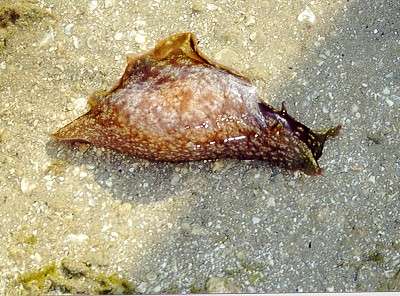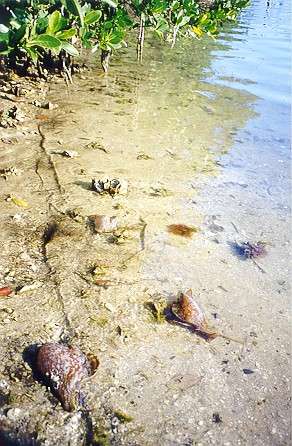Sea Hares - mass mortality
September 9, 1999
From: Anne DuPont


Dear Bill,
Here is a copy of a letter I have sent to P.M. Johnson, who I see in the Forum is a PhD student in zoology at the University of Washington working on defense in sea hares.
This spring, March, I was on a trip on my boat on the west coast of Florida (USA). We were anchored off the Tween Waters Resort on Captivia Island. I was very shocked to see dozens of dead Sea Hares along the shore.
I am sending you a couple of photos, one of a Sea Hare and one shows the environment. I ask a local fisherman and he said that it happened a lot. This was along the shore in front of the marina and I was wondering if gas and diesel in the water would kill them. The ones that were not dead seemed to be dying the the shallow water. I picked up one that seemed to be dying and it inked me.
I sent out several e-mails inquiring about the cause and this is the best reply I received.
Dear Mrs. DuPont,
Very hard to tell what kill the sea hares without being there; I know for a fact that there was a mild case of red tide earlier this year, stronger on Captiva than on Sanibel, but your picture of the environment does not seem to show the unusually dirty shore line that we see during episodes of red tide. If the animals died as a result of congregation during the mating season, you might have witnessed a result of the "mating frenzy" (not so much of a frenzy in sea-hares though). Last but not least, it could be oil in the water; these animals move up and down the bay, and if they hit a locally polluted marina, there you go, although I really cannot say that Tween Waters, or anywhere else in Captiva is "polluted". Thanks for forwarding the message to me,
Jose H. Leal, PhD
Director, The Bailey-Matthews Shell Museum
Editor-in-Chief, The Nautilus
leal@water.net
3075 Sanibel-Captiva Road
P.O. Box 1580
Sanibel, FL 33957
I hope this helps your research.
Cordially,
Anne DuPont
adupont@gate.net
DuPont, A., 1999 (Sep 9) Sea Hares - mass mortality. [Message in] Sea Slug Forum. Australian Museum, Sydney. Available from http://www.seaslugforum.net/find/1305Dear Anne,
Thanks for the photos and information. Although pollution could be involved, I think it more likely that you saw a natural event occurring. I have discussed these cases of 'mass mortality' a number of times in messages scattered throughout the Forum. So I have made a Mass Mortality page where I have put links to most of the relevant messages and discussions. From the many messages on the A. brasiliana page in recent months, it has been a good year in Florida from Sea Hares. There is also a recent report on mass mortality of Aplysia dactylomela in Florida as well.
If population numbers have been high, then when these animals complete their life cycle, death is more noticeable, as large numbers are found dead together.
I am interested in trying to identify which species your photos are of. Did any of the animals show signs of flapping their parapodia and swimming, or were they too far gone to know? I am afraid the scientific literature is not very clear on identifying species of Aplysia from the east coast of the Americas. I have been calling the swimming species Aplysia brasiliana but now have my doubts. Perhaps your animal is true A. brasiliana Rang 1828, which grows to 270mm, and is reported from New Jersey to Brazil.
Or perhaps it is A. cervina Dall & Simpson 1901, which grows to 100mm and is reported from USA to Brazil. Eales (1960) described it as 'dappled light & dark, no evidence of swimming.
Considering how many queries and observations the Forum is getting about Sea Hares from Florida and the Caribbean, it would be useful to have some clarification, and photos of the species. Any help from anyone reading this would be much appreciated.
Bill Rudman.
Related messages
-
Stranding of Sea Hares in New South Wales
From: Brenda Harris, July 2, 2007 -
Mass Stranding of Sea Hares in nthn New South Wales
From: Belinda Allman , February 14, 2007 -
Re: Mass Stranding of Sea Hares in nthn New South Wales
From: Inger Vandyke, January 16, 2007 -
Mass Stranding of Sea Hares in nthn New South Wales
From: Michael Hill, January 15, 2007 -
Re: Mass mortality of Aplysia californica
From: Ellen Hall, September 5, 2005 -
Ebro Delta, Spain - Large Sea Hares
From: Jorge Jimenez, August 20, 2005 -
Migration inshore of Aplysia punctata
From: Dr. Stephen Hoskins, June 11, 2003 -
Bloom of Aplysia in Portugal
From: Manuel Malaquias, September 17, 2002 -
Swarming in Stylocheilus striata
From: John Hoover, April 7, 2002 -
Swarming behaviour in Aplysia
From: Dr. Stephen Hoskins., April 3, 2002 -
Re: Sea Hares - mass mortality
From: Anne DuPont, September 28, 1999 -
Re: Sea Hares - mass mortality
From: Wayne Ellis, September 10, 1999
